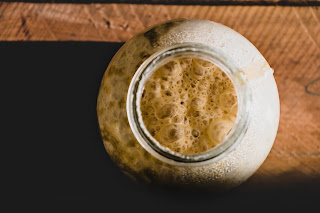What’s That Liquid On Top Of Your Sourdough Starter
I. Introduction
Sourdough bread is a staple in many households, and the key ingredient that makes it unique is the sourdough starter. This naturally fermented mixture of flour and water is what gives sourdough bread its distinct flavor and texture. However, when maintaining your sourdough starter, you may notice a liquid on top of it. This liquid can be a cause of concern for many bakers, but it's essential to understand what it is and how to manage it.
II. Understanding Sourdough Starter
A sourdough starter is a mixture of flour and water that has been left to ferment naturally. The fermentation process is what creates the unique flavor and texture of sourdough bread. The starter is made up of wild yeasts and bacteria that live on the surface of the flour and in the air. These microorganisms break down the carbohydrates in the flour, producing lactic acid and other compounds that give the bread its characteristic sour flavor.
Maintaining a healthy sourdough culture is essential for consistent results. Proper feeding and temperature control are key factors that can affect the health of your sourdough starter.
III. Explaining the Liquid On Top Of Your Sourdough Starter
The liquid on top of your sourdough starter is known as hooch. It can appear as a clear or brownish liquid and is a result of the fermentation process. The hooch is formed when the yeast and bacteria in the sourdough starter consume the carbohydrates in the flour and produce alcohol and carbon dioxide. The alcohol then rises to the surface and forms the liquid layer.
If you notice hooch on top of your sourdough starter, it's important to identify whether it is hooch or simply water. Hooch has a distinct smell and taste, while water is odorless and tasteless.
The causes of hooch formation can be either overfeeding or underfeeding your starter. Overfeeding can lead to an excess of alcohol production, while underfeeding can lead to a lack of food for the microorganisms in the starter.
To manage hooch, you can either remove it from the surface of the starter, mix it back into the starter, or use it in your baking.
IV. Using Hooch As A Baking Ingredient
Hooch can be used as an ingredient in bread-making. It can add a subtle alcoholic flavor to the bread, enhancing its taste. When adding hooch to your bread dough, it's important to note that it can affect the texture of the bread. Adding too much hooch can result in a denser and more compact bread.
Experimenting with different types of alcohol can also add different flavors to your bread. Using beer or wine can give your bread a unique and interesting taste.
V. Conclusion
In conclusion, understanding the liquid on top of your sourdough starter is essential for maintaining a healthy and consistent sourdough culture. By identifying whether it's hooch or water, investigating the causes, and discussing solutions, you can manage it effectively. Additionally, using hooch as a baking ingredient can add a unique flavor to your bread. Remember to experiment with different types of alcohol and use it in moderation. With these tips, you can master the art of sourdough bread-making and produce delicious bread every time.


